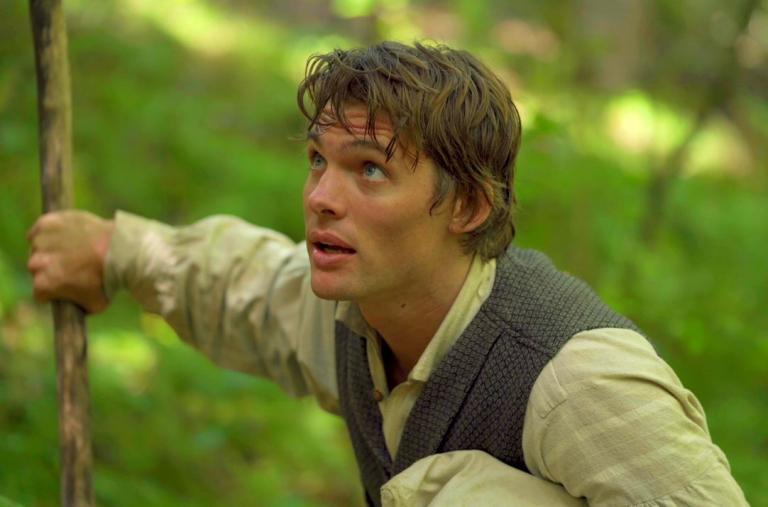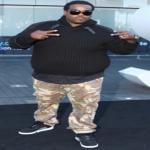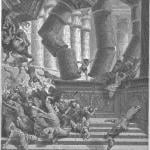
(Still photograph from the set of the Interpreter Foundation’s “Witnesses” film project, courtesy of James Jordan)
***
Just a reminder, for whoever cares, that I’ll be on the Interpreter Radio Show with Martin Tanner and Terry Hutchinson between 7 PM and 9 PM (Utah time) this evening. One hour of the two-hour program — probably the second hour, but I’m not certain of that — will be devoted to a discussion of Doctrine and Covenants 76, which is the account of their magnificent vision of the three degrees of glory written by Joseph Smith and Sidney Rigdon. The other hour will focus — and aren’t you surprised! — on the Witnesses film, which officially premieres at Thanksgiving Point, in Lehi, Utah, on Wednesday, 2 June, and then opens nationwide thereafter.
If you’re in the Salt Lake Valley, you can probably listen in on K-TALK, AM 1640. Elsewhere, but perhaps even in the Valley itself, the better option would be to listen live on the Internet at ktalkmedia.com. I’ve done that myself, very successfully, from elsewhere in Utah and, in fact, from outside of the state.
***
I’m grateful to the folks at FAIR, a sister organization to the Interpreter Foundation, who have generously stood beside us to help in publicizing the new Witnesses film, which will be available in theaters across the United States later this week. Just a few days ago, for example, they sent out their regular newsletter, including this time a message from me that reads as follows:
The Interpreter Foundation’s theatrical film “Witnesses” opens officially on Friday, 4 June. (See more here.) In fact, it will be screened in some locations beginning already on the evening of Thursday, 3 June, and its premiere will occur at Thanksgiving Point in Lehi, Utah, on Wednesday evening, 2 June.
Those who see it will soon recognize that they’re not watching a film produced for a Church visitors center. Not because it’s faithless or critical, but because it will raise issues that official Church movies typically don’t raise.
Only about two hours long and featuring four distinct protagonists—the Three Witnesses of the Book of Mormon, alongside Joseph Smith—the film simply cannot go into great depth on individual controversial topics. Nevertheless, “Witnesses” will expressly address such challenging issues as early plural marriage, the rise of dissent and rebellion in the late 1830s, the failure of the Kirtland Bank amidst the national Panic of 1837, and the apostasy of the Witnesses themselves. There will be disagreements, anger, and bruised egos, along with moments of tenderness and revelatory power.
Why? Not, certainly, to attack the Church or any of its early leaders. Partially, we do it because that’s how the story actually happened, and because to omit such elements of it would risk being perceived as a “whitewash”—a perception that would damage the film’s credibility. We also do it, though, because it’s only by understanding what the Three Witnesses went through, and the causes and depth of their disaffection, that audiences can fully appreciate the contrasting power of their never-faltering testimonies of the angel, the plates and other Nephite artifacts, and the voice of God affirming the truth of the Book of Mormon. Oliver Cowdery and Martin Harris returned to the Church late in their lives; David Whitmer did not, but he remained rock solid in testifying to what he had seen and heard.
Among the concerns that one or two shared with me early in the filming was that our actors were so very young. But so, too, were Joseph, Oliver, and David. At 46, Martin Harris was by far the oldest among them. “Witnesses” depicts an emerging prophet, a young man who is learning how to listen and to lead. He will continue to learn into the Church’s Nauvoo period, but that time is mostly beyond the narrative of the film.
And the story is incomplete in other ways, as well. “Witnesses” will be followed within a few months by an accompanying docudrama that will include not only the commentary of both faithful Latter-day Saint scholars and others on the events depicted in the theatrical movie, but the stories of the Eight Witnesses and the informal additional witnesses. It will answer many of the questions that we want the dramatic film to stimulate. Shortly thereafter, a small fleet of short features will be deployed to address very specific issues and objections. Finally, a just-launched and still-expanding website not only complements the films but will continue long past their initial runs.
I hope that the folks at FAIR won’t mind my reproducing that short article here.
And now, two new podcast interviews conducted by Hanna Seariac have gone up just this morning:
FAIR Voice #34: Witnesses Pt. 1 with Daniel C. Peterson
“FAIR Voice #35: Witnesses pt. 2 with actors for Joseph Smith and Oliver Cowdery”
FAIR is an excellent organization that richly deserves your support — and not merely because they’re being so helpful with Witnesses! And please don’t miss their marvelous annual conference, which falls, this year, on 4-6 August.
Interestingly, there is at least one issue that came up in both of the Hanna Seariac interviews: Later estimates of the weight of the gold plates of the Book of Mormon (by those who had briefly held them, such as the official witness Martin Harris and the unofficial witness William Smith) put that weight at somewhere in the range of forty to sixty pounds. Some critics, accordingly, have contended that Joseph Smith could not have carried them for any significant distance, let alone run with them through the woods. The plates — if they actually existed and if they weighed as much as the witnesses say they did — were simply too heavy. Thus, these critics argue, at least that portion of his story must be fraudulent.
With that argument in mind, I call your attention to a scene that you will see early on in Witnesses in which Joseph Smith, who is played by Paul Wuthrich, runs through a forest while being chased by money diggers and carrying the plates.
I’ve noted previously that I was not present on the outdoor “set” for that day’s filming, but I’ve offered some background on the scene that is directly relevant to the critics’ argument. It’s based on communication with Russell Richins and James G. Jordan, who are, respectively, the producer and associate producer of Witnesses:
Knowing that filming the scene of Joseph running with the plates would require several hours, Paul Wuthrich was presented with the option of going with something lighter as a prop, including a bag filled with a block of styrofoam. He realized, though, that running with a light block of styrofoam would look quite different from the gait of someone carrying an actual dense and heavy object. Se he chose, instead, to use the lighter of the two prop sets of plates that metallurgist Dave Baird, based on careful research, had created. The two of them came to be rather humorously referred to as the “hero set” (approximately 45 pounds) and the “non-hero set” (approximately 35 pounds). Wuthrich chose the lighter of the two, but both were in, or close to, the range historically given for the actual plates found in Cumorah.
During the filming of Witnesses, the two sets were switched out at various times. Sometimes the secondary or “non-hero” prop was used, and sometimes the “hero set.” “At all times,” comments Russell Richins, “when you see Paul Wuthrich running or using the plates in the scenes, he is using one of these two sets. Bottom line, Paul was in very similar circumstances that Joseph Smith faced except for this one exception – – Paul Wuthrich did it over and over and over again throughout the day. Yes, he was exhausted, but he did it. A whole crew witnessed it.”
Those who have not been involved with filming of this sort would, I think, be astonished at how many takes and re-takes need to be done for even relatively simple indoor scenes. Equipment is laboriously moved from one place to another. Scenes are filmed multiple times in order to get things “just right.” They are recorded from various angles, from one side and then from another. From up close and from a distance.
Paul Wuthrich ran down the hill repeatedly, carrying the plates, jumping over rocks and logs, trying to avoid low branches. He did it many times, for different takes, so that filming could be done from a variety of angles. He had to run down the hill with the plates, then climb up the hill once more with the plates, then run down the hill, then climb up the hill again, then run down the hill yet again.
In his interview with Hanna Seariac, Brother Wuthrich remarks that, at first, the film crew were applying water to him to make him look sweaty. After a very little while, though, they no longer needed to do that. He was sweating profusely, no help required.
I like Russell Richins’s summary statement:
Whether they want to accept it or not, people are going to have to face the fact that Joseph Smith, used to day labor and a very fit individual known for his strength, was fighting for his and the plates’ safety, perhaps even his life. Additionally, this claim would have been quite achievable for many young men of his time.
And we’re not even invoking the adrenaline that being chased by armed enemies would elicit, let alone supernatural or divine aid.
So, when you watch that scene of Joseph running through the woods with the plates, please realize that you’re also watching, in real-world visual form, the refutation of an argument that has been leveled against the Book of Mormon.











